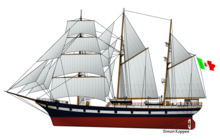Palinuro (A 5311)
The Palinuro (formerly Commandant Louis Richard and Jean Marc Aline ) is a sailing training ship of the Italian Navy .
history


The name Palinuro comes from Palinurus , the helmsman of Aeneas from Roman mythology.
In 1933, Joseph Briand, President of the French Société des Pècheries Malouines , commissioned the Anciens Chantiers Dubigeon shipyard in Nantes to build two steel- hulled sailing ships, breaking a long tradition. A year earlier, the two sister ships Étoile and Belle Poule had been built for the Navy based on the model of the Icelandic schooner using oak. The two new ships were called Lieutenant René Guillon and Commandant Louis Richard . They were as barquentines - with square sails on the foremast and fore-and-aft rig at wholesale and mizzen - rigged and had each come with a 150 hp diesel engine . However, the cost of this construction ruined the shipowner , and he sold the ships before they left for their first catch. The new owners were the Pècheries du Labrador in Saint-Malo , headed by Michel Glâtre . Since the two ships were specifically designed for catching cod , an upgrade to the schooner followed . The Lieutenant René Guillon was used until 1951, now she is in an Asian port and her rigging has been removed.
In contrast, the Commandant Louis Richard , now Palinuro , had a happier fate. After setting sail from Saint-Malo in 1934 for her first and immediately successful fishing, the shipping company had refrigerated chambers installed in January 1935. The ship had thus experienced a significant upgrade and now also had the most modern technical equipment. A year later, the Commandante Louis Richard became the property of a fishing company based in Saint-Malo.
After another change of ownership in 1948 - the new owner was the shipping company Bonin in Noirmoutier-en-Île - the barquentine set off in search of new fishing grounds in the southern Indian Ocean . Renamed Jean Marc Aline , she finally cruised off the islands of Saint Paul and Nouvelle Amsterdam . However, these trips turned out to be unprofitable. After the French Navy considered using the ship as a training ship, the Italian Navy seized the opportunity in 1951 and bought it.
Italy could already look back on a long tradition of sailing training ships. This began in 1861 with the frigate San Michele and reached its climax with the launch of the Cristoforo Colombo (1928) and the Amerigo Vespucci (1931). The Jean Marc Aline should take the place of Ebe and passed to the Soviet Union Cristoforo Colombo occur and to train Navy - commissioned officers serve. After a thorough overhaul, it was renamed Palinuro and commissioned on July 1, 1955. The ship was assigned to the non-commissioned officers' school in La Maddalena in Sardinia , and later that of Taranto . The Palinuro is used for the nautical training of prospective Portepee NCOs.
After the Palinuro had been at sea for 25 years, the Italian Navy considered building a new one, but thanks to the commitment of the crew, the Palinuro was completely overhauled. The Barkentine was repaired between 1984 and 1986 and is now back at sea.
She has already taken part in numerous tall ship events, including the " Cutty Sark Tall Ships' Race " in the Baltic Sea in 2000 , the " Sail Bremerhaven " and the " Hanse Sail " in 2003.
Technical specifications
- Year of construction: 1934
- Shipyard: Anciens Chantiers Dubigeon, Nantes
- Overhauls: 1954/55 and 1984/86
- Type: (three-masted) barquentine
- Hull material: steel
- Overall length: 68.9 m
- Body length: 59.0 m
- Width: 10.1 m
- Draft: 4.8 m
- Sail area 898.8 m²
- Displacement: 1341 t
- Home port: La Spezia (formerly La Maddalena)
- Owner: Italian Navy
- Flag: Italy
See also
During the Second World War , the Regia Marina used the Yugoslav sailing training ship Vila Velebita from 1941 to 1943, also under the name Palinuro, as a sailing training ship.
Web links
- Brief description and photos of the Palinuro on SchiffsSpotter.de , accessed on August 5, 2008
- Description on the website of the Italian Navy
